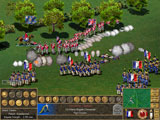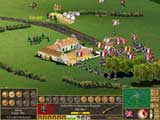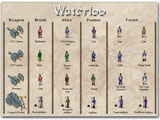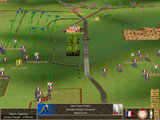 Unfortunately for
Strategy First’s and Breakaway Games’ Waterloo: Napoleon’s Last Battle, the
most attractive thing about it is also one of its biggest problems: it looks a lot like a
game of toy soldiers. To hardcore wargamers, this means it looks a lot like a Napoleonic
miniatures game, and they’re going to expect the same sort of detail found in
miniatures rules like Column, Line, and Square or Empire or Napoleon’s Battles. On
the other hand, to the gaming community at large this game will look like a game with toy
soldiers, and they’ll expect the sort of complexity one associates with playing in
the sandbox. Neither of these groups is going to get what they expect. Waterloo is neither simple nor pretty enough to
endear itself to casual gamers nor detailed enough for the hardcore ones, and this misstep
combined with subpar graphics, a creaking game engine, and some very dubious modeling of
Napoleonic warfare makes for a game that just seems dated and kludgy circa 2001. Unfortunately for
Strategy First’s and Breakaway Games’ Waterloo: Napoleon’s Last Battle, the
most attractive thing about it is also one of its biggest problems: it looks a lot like a
game of toy soldiers. To hardcore wargamers, this means it looks a lot like a Napoleonic
miniatures game, and they’re going to expect the same sort of detail found in
miniatures rules like Column, Line, and Square or Empire or Napoleon’s Battles. On
the other hand, to the gaming community at large this game will look like a game with toy
soldiers, and they’ll expect the sort of complexity one associates with playing in
the sandbox. Neither of these groups is going to get what they expect. Waterloo is neither simple nor pretty enough to
endear itself to casual gamers nor detailed enough for the hardcore ones, and this misstep
combined with subpar graphics, a creaking game engine, and some very dubious modeling of
Napoleonic warfare makes for a game that just seems dated and kludgy circa 2001. Waterloo portrays
the battle of Waterloo in real-time (though you can pause) at the battalion level. It uses
the same basic engine as Sid Meier’s Gettysburg and Antietam!, but this engine was
showing a few varicose veins with Antietam, and it’s out-of-the-grave-zombie old now.
While the SMG engine did a pretty fair job of representing Civil War warfare, Napoleonic
warfare is a different beast entirely and unfortunately Breakaway Games’ tinkering
under the hood hasn’t successfully captured the feel of column/line/square warfare.
 Waterloo offers
many scenarios, from small to medium to large to huge. Aficionados of the battle will
appreciate the obvious knowledge Breakaway demonstrates in dividing the battle up into the
separate, easily recognizable “acts” that Waterloo historians typically use to
designate the battle’s phases. There’s the assault on Hougoumont, the
destruction of the Dutch/Belgian brigade, the attack of D’Erlon’s corps, the
counterattack of the British cavalry, the grand French cavalry assault, the Prussian
approach and the struggle for Placenoit, the advance and decimation of the Guard.
Unfortunately, most of these scenarios are impossible to play with any degree of facility,
typically because the game’s real-time system demands micromanagement that just
doesn’t mesh with grand-tactical scope of the scenarios. While the smaller scenarios
are manageable, the medium-sized ones are damned difficult to stay on top of, even if
you’re leaning on the pause button. This
wasn’t as much of a problem with Gettysburg or Antietam; in them, you could pretty
much leave a brigade in line and let it fire away until you needed to move it. But Napoleonic warfare is very much a
rock/paper/scissors kind of game—line formation is great for shooting, but slow and
lousy for assault and death against cavalry; columns are fast and great for melee, but bad
for shooting and make a great target for artillery; squares provide the best defense
infantry has against cavalry, but are very vulnerable to fire and assault. Making sure
that your units are in the right formation at the right time is crucial, and
Waterloo’s real-time format makes this an almost impossible task. If you really want
to experience frustration, Breakaway has included a scenario that allows you to play the
whole battle. Go ahead, knock yourself out. It probably would have been a better design
decision to include a branching campaign like Gettysburg's’, but the lure of the
grandiose apparently proved to great. Waterloo offers
many scenarios, from small to medium to large to huge. Aficionados of the battle will
appreciate the obvious knowledge Breakaway demonstrates in dividing the battle up into the
separate, easily recognizable “acts” that Waterloo historians typically use to
designate the battle’s phases. There’s the assault on Hougoumont, the
destruction of the Dutch/Belgian brigade, the attack of D’Erlon’s corps, the
counterattack of the British cavalry, the grand French cavalry assault, the Prussian
approach and the struggle for Placenoit, the advance and decimation of the Guard.
Unfortunately, most of these scenarios are impossible to play with any degree of facility,
typically because the game’s real-time system demands micromanagement that just
doesn’t mesh with grand-tactical scope of the scenarios. While the smaller scenarios
are manageable, the medium-sized ones are damned difficult to stay on top of, even if
you’re leaning on the pause button. This
wasn’t as much of a problem with Gettysburg or Antietam; in them, you could pretty
much leave a brigade in line and let it fire away until you needed to move it. But Napoleonic warfare is very much a
rock/paper/scissors kind of game—line formation is great for shooting, but slow and
lousy for assault and death against cavalry; columns are fast and great for melee, but bad
for shooting and make a great target for artillery; squares provide the best defense
infantry has against cavalry, but are very vulnerable to fire and assault. Making sure
that your units are in the right formation at the right time is crucial, and
Waterloo’s real-time format makes this an almost impossible task. If you really want
to experience frustration, Breakaway has included a scenario that allows you to play the
whole battle. Go ahead, knock yourself out. It probably would have been a better design
decision to include a branching campaign like Gettysburg's’, but the lure of the
grandiose apparently proved to great.
 It’s very odd,
but Waterloo is actually a fairly entertaining game until your units get into combat, when
everything sort of goes to hell. Lining up a corps of French infantry and sending them off
to face the thin red line of Brits is pretty stirring, and can look almost cinematic.
However, once units start mixing it up it becomes very difficult to tell who’s
fighting whom or what direction units are facing, and the interface can be extraordinarily
clunky when trying to command units in a crowd. Once engaged, units often seem to have a
mind of their own, and not a very tactically savvy one. I know combat is a confusing mess,
but it can’t be this confusing. It’s very odd,
but Waterloo is actually a fairly entertaining game until your units get into combat, when
everything sort of goes to hell. Lining up a corps of French infantry and sending them off
to face the thin red line of Brits is pretty stirring, and can look almost cinematic.
However, once units start mixing it up it becomes very difficult to tell who’s
fighting whom or what direction units are facing, and the interface can be extraordinarily
clunky when trying to command units in a crowd. Once engaged, units often seem to have a
mind of their own, and not a very tactically savvy one. I know combat is a confusing mess,
but it can’t be this confusing.
 The game system has
its ups and downs. Some aspects of Napoleonic warfare are very well done. For example,
British infantry in line is a terror, using combined arms is essential, and unit cohesion
plays a large part in the game—the gradual wear and tear of a fight slowly ground
down many Napoleonic formations. Often you’ll want to send a near full-strength unit
into combat only to discover that the long march to enemy lines has fatigued and
disorganized it past usefulness. This is realistic and very elegantly done. On the other
hand, some things are not handled very well. As in Antietam, routing is still a problem.
Generals and units often panic and flee behind enemy lines, where they almost invariably
end up rallying and then moving to capture objectives, which is insane. Artillery displays astonishingly stupid AI,
invariably choosing to fire counter-battery even when big juicy infantry units in square
are standing right in front of them. Artillery crews do not shelter in nearby squares when
charged. Blown cavalry sort of mills around
in the middle of the battlefield taking fire without much effect. Squares get broken far
too often. And while there’s some nice background information on the battle and the
manual and tutorials are solid, there’s no option to remap hot keys. The game system has
its ups and downs. Some aspects of Napoleonic warfare are very well done. For example,
British infantry in line is a terror, using combined arms is essential, and unit cohesion
plays a large part in the game—the gradual wear and tear of a fight slowly ground
down many Napoleonic formations. Often you’ll want to send a near full-strength unit
into combat only to discover that the long march to enemy lines has fatigued and
disorganized it past usefulness. This is realistic and very elegantly done. On the other
hand, some things are not handled very well. As in Antietam, routing is still a problem.
Generals and units often panic and flee behind enemy lines, where they almost invariably
end up rallying and then moving to capture objectives, which is insane. Artillery displays astonishingly stupid AI,
invariably choosing to fire counter-battery even when big juicy infantry units in square
are standing right in front of them. Artillery crews do not shelter in nearby squares when
charged. Blown cavalry sort of mills around
in the middle of the battlefield taking fire without much effect. Squares get broken far
too often. And while there’s some nice background information on the battle and the
manual and tutorials are solid, there’s no option to remap hot keys.
 And the graphics
are just dated. While Breakaway went a ways to show all the different uniforms in their
accurate glory, the 2D unit sprites combine jerky animation and blocky graphics, and look
downright nasty up close. Scroll drag is awful, even on a hot machine. Even worse, the lay
of the game’s terrain is difficult to determine unless you turn on an unsightly grid
overlay. And the graphics
are just dated. While Breakaway went a ways to show all the different uniforms in their
accurate glory, the 2D unit sprites combine jerky animation and blocky graphics, and look
downright nasty up close. Scroll drag is awful, even on a hot machine. Even worse, the lay
of the game’s terrain is difficult to determine unless you turn on an unsightly grid
overlay.
I imagine the best
way to play Waterloo would be multiplayer, with several different commanders on each side.
While this is indeed possible, I’ve yet to find a dedicated server or for that matter
many opponents online. Better multiplayer support would have been welcome.
I remember playing
Napoleonic miniatures in my youth. It took hours to clean, research, paint and mount those
damn things. I can remember my excitement when computer games promised all the spectacle
and gameplay of minis with none of the drudge work. I’m still waiting.
Rick
Fehrenbacher |
